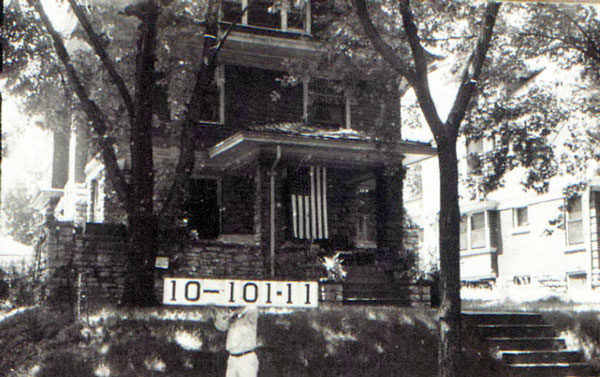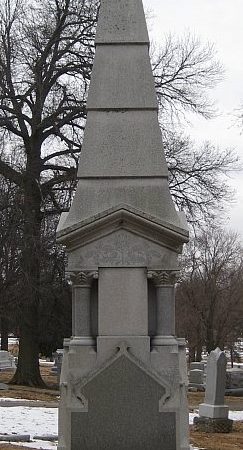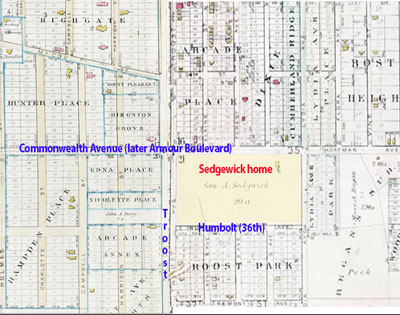
A Midtown Memorial Day tribute goes to George Sedgewick, a Kansas City pioneer who lived at Armour and Virginia before his 20 acres were platted as Sedgewick Place. Like many pioneers, Sedgewick wasn’t born here but was attracted to the growing railroad hub and potential for Kansas City’s growth. When Sedgewick, born in 1823, was buried in his adopted hometown in Forest Hill cemetery, he had become part of Midtown’s development legacy.

As part of our Uncovering History Project, the Midtown KC Post is examining each block in Midtown. A set of 1940 tax assessment photos is available for many blocks.
Today’s focus is the block from Tracy to Virginia, from Armour Boulevard to W. 36th Street.
Railroads Brought Kansas City Pioneer to Town
Many of Kansas City’s pioneers followed the promise of Kansas City’s thriving railroad industry to town, and George Sedgewick was no exception. Sedgewick was from a prominent Scottish-English family back east, but after being orphaned at an early age, went to live with an uncle in Pennsylvania. Starting in the railroad business there, he came to Kansas City as an agent and then superintendent for the Kansas Pacific Railroad Company (which became the Union Pacific). He later partnered with Edward Phillips to furnish ties to the railroads.
Like many early arrivals to Kansas City, Sedgewick purchased a large plot of land, in his case, twenty acres at what was then the outskirts of town. He and his wife built a “commodious and fine residence at the corner of Virginia and Armour.” After George’s death, historian Carrie Westlake Whitney wrote of the home then occupied by Nannie Sedgewick in the book Kansas City: Its History and Its People 1808-1908:
She also has two blocks on Armour Boulevard and building lots on Virginia Street and the Paseo. Her realty also embraces several fine residences elsewhere in the city, from which she derives a good rental. In her house she has a very fine library and beautiful paintings and other works of art, which indicate a refined and cultured taste. She also has many relics of early pioneer days in Kansas City.
Those relics included the old dining table and several chairs from the Gillis House Hotel.

The Sedgewick property in 1891, when other large tracts around theirs had begun to be platted.
The Block Fills in in Early 1900s
The Sedgewicks later sold off some of their property, and the block of Tracy to Virginia began to fill in with homes a few years after 1900. Although several 1940s photos of the block have been lost, those that remain show the homes as they looked that year.
Historic photos courtesy Kansas City Public Library/Missouri Valley Special Collections.
George Washington Sedgewick’s son, Lee Massachusettes Sedgewick, named after George’s hometown, donated the first building to Rockhurst College. The building was not named for Lee during his lifetime (1860-1935) as he wished to remain anonymous (the name was added in1942). The building, at 51st & Troost, is called Sedgwick Hall, with the second “e” dropped. Lee was born in Indiana, Pennsylvania and died in Hot Springs, Arkansas. The Sedgewick Rail Tie company supplied railroads with product made from the timber holdings of the Sedgewick’s in Arkansas. Sedgwick, Arkansas, without the second “e,” is named for George (1823-1899). Nannie (1841-1909) was George’s second wife and she died in the Virginia Avenue home. Lee’s mother was Margaret Bell (1833-1868). The other Sedgewick children were Frank Fenn Sedgewick (1855-1920) and Mary Belle Sedgewick Craig (1865-1938).